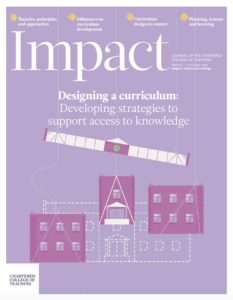A reflection on modern languages pedagogy and how teachers might engage with research

The context of modern languages teaching
It is easy to argue that modern language teaching in English-speaking countries is in crisis. In England, the supply of advanced-level linguists has dwindled rapidly since the 1990s, university language departments have closed and less than half of all secondary students take a language at GCSE (Tinsley and Doležal, 2018). It is in this context that in 2016, the Teaching Schools Council (TSC) published the Modern Foreign Languages (MFL) Pedagogy Review, which put forward a range of recommendations for improving languages provision and teaching. The review raises not only a number of important methodological issues for language teachers, but also general questions about why all teachers should engage critically with research.
What is the TSC
The TSC is a national body made up of 20 members whose aim is to lead and help shape the work of over 800 Teaching Schools (those that have been nationally recognised for their capacity to support and help other schools to improve outcomes).
In the case of the MFL Review, head teacher and linguist Ian Baulkham led an advisory group, which included the Vice Chair of the TSC along with five specialists from the MFL field, including two university academics, one a specialist in applied linguistics.
The advisory group took evidence and opinion from a range of sources: written evidence from stakeholder organisations, school visits, interviews with teachers from 33 schools and a literature review.
What did the TSC recommend?
Whilst the review does not prescribe a ‘best way’ to teach languages in all circumstances, it does put forward a number of recommendations, which include the following:
- Students need to acquire systematic knowledge and do planned practice of the vocabulary, grammar and phonics of the language being studied
- Content should be stimulating and widen students’ knowledge of the culture, history and literature of the new language, without compromising the sequencing of vocabulary and grammar
- Textbooks should be chosen on the basis of how they support a planned approach
- Students should do translation and read short texts and literature
- The four skills of speaking, listening, reading and writing should be taught together.
Many of these recommendations are to be welcomed. I would pick out, for example, the priority given to careful planning of vocabulary instruction – in particular, verbs; the advice on giving explicit but succinct accounts of grammar; the support for judicious use of technology; the importance of presenting grammatical structures in listening and reading input; the value of practising new structures in both tightly controlled exercises and free writing; specific advice on how much grammar to cover in a year; and the value of early teaching of sound–spelling correspondences to develop accurate pronunciation and ‘phonological memory’ of words. In addition, the encouragement to make use of appropriate, adapted, authentic resources to supplement a textbook is important.
What does this mean for the classroom?
With regard to listening and reading resources, the review states that they ‘… should contain a critical proportion of language which has been taught and can be used and understood by pupils’ (TSC, 2016). This recommendation is supported by research that suggests that as much as 98% of the vocabulary of a reading or listening text should already be known to students for it to be comprehended (Nation, 2013).
Pair and group work are encouraged as long as the focus is on genuine (structured) communication, such as in ‘information-gap’ tasks and where there is some need to manipulate language rather than just recall rehearsed chunks of language. This is supported by research indicating that authentic interaction is a necessary prerequisite for acquisition (Long and Doughty, 2009).
Limitations of the TSC Review
Having summarised these positive points, let me point out some limitations of the TSC Review.
The TSC Review’s evidence relies relatively more on teachers’ and consultants’ views than a full range of research evidence. As such, it should be read with a degree of caution. The TSC limited their literature review to studies specifically involving the teaching of students learning languages in England, which yielded just 26 studies of relevance. A broader review of language teaching, carried out by Ellis (Ellis, 2005) for the New Zealand Ministry of Education, a parallel context to the UK, examined a number of pedagogic approaches and general theories that can be applied to second language teaching, but was not based on observations of lessons or discussions with teachers.
Although there is a great deal of overlap between the reports, the Ellis review has a slightly different emphasis, focusing rather more on interaction and communicating meanings. Among his 10 principles for instruction are:
- Instruction needs to take into account the learner’s ‘built-in syllabus’
- The opportunity to interact in the new language is central to developing proficiency
- Instruction needs to ensure that learners focus predominantly on meaning
- Instruction needs to take into account individual differences in learners.
By referring to a ‘built-in syllabus’, Ellis means that when students learn a second language, they tend to master certain aspects of grammar in a ‘natural order’, which is at least partly at odds with the sequence in which structures are presented and practised by the teacher (Krashen, 1982) (Zobl, 1995). Although we can get students to explain rules and perform exercises accurately, they frequently fail to use these rules in unrehearsed speech or writing. For the lay person and many a teacher, it seems counterintuitive that students do not acquire what we teach, but this research relating to the order in which aspects of grammar are acquired should not be overlooked. It seems that learners become ‘ready’ to use points of grammar in their own time after receiving a certain amount of linguistic input.
Debates on second language acquisition
In the research literature over the years, there has been tension between two views of how languages are learned. Firstly, there are those who prioritise implicit learning, i.e. picking up the language through exposure to meaningful messages (VanPatten, 2014). Proponents of this approach argue that languages are learned by focusing almost totally on meaning, and not the grammar of the language.
The second perspective tends to see language learning as analogous to the learning of any complex skill (Anderson, 1982); (Leow, 2015). It uses constructs such as automaticity and working/long-term memory, arguing that, as the TSC Review puts it, ‘… through regular, meaningful practice, learning becomes stored in long-term memory (sometimes known as procedural memory) and can be accessed without conscious thought’ (TSC, 2016, p. 8). In its emphasis on sequenced grammar teaching reinforced by translation, the TSC Review is more clearly in this second camp. In this respect, some scholars would argue that it is out of line with what many studies tell us about second language acquisition. Even Leow (Leow, 2015), a supporter of explicit learning, states, ‘Whether the role of consciousness/awareness is crucial for further processing to take place, and ultimately for learning, has been and will remain a contentious issue.’ (p. 58)
What should teachers take from this?
Firstly, research into second language learning provides relatively nebulous overall guidance about how to teach a language, even if it can offer very useful pointers on specific aspects. As the TSC Review says, there is no ‘best way’ that can be recommended for the classroom. But without some knowledge of the full range of research, teachers cannot critically evaluate the recommendations they are presented with. Second language acquisition is a highly complex process and research is only several decades old. As Lightbown and Spada (Lightbown and Spada, 2011) have written (p.180):
Classroom-based research on second language learning and teaching has given us partial answers to many questions. Through continuing research and experience, researchers and teachers will fill in more details, always recognising that no single answer will be adequate for all learning environments.










